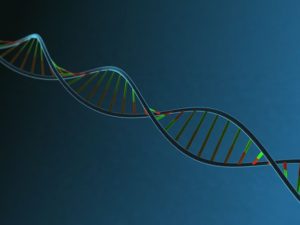This week is a continuation of the evidence for the existence of God from the Teleological Argument, specifically in the design factors found in biochemistry. These factors can be seen in things like the irreducible complexity of structures in living things such as a bacterial flagellum, the eye, the ear and the blood clotting factor. We also find evidence of intelligence in the design of DNA where information has been coded in detail for every living thing, individually. We will also provide references for going deeper for those who would like to explore these concepts further.
Watch this week’s class presentation on this topic:
Overview Notes From the Presentation
Topic #2: Conversations About God
Part 1: How Do We Know God Exists?
III. The Teleological Argument for the existence of God
Design in Biochemistry
Premise #1: Whatever has the appearance of design must have a designer. For example, a building must have a builder, a painting or sculpture must have an artist, and a computer must have a programmer.
*Premise #2: Living things have the appearance of design. Irreducible complexity and the information code in DNA provide evidence of design in living things.
Premise #3: Therefore, living things have a designer.
The Teleological Argument for the existence of God
Intelligence in Biochemistry: Evidence from inside our bodies and the information codes contained therein point to design, and therefore an intelligent designer.
Noted Atheists admit design:
Richard Dawkins, noted Biologist and Atheist, in his book “The Blind Watchmaker,” said…
“Biology is the study of complicated things that give the appearance of having been *designed for a *purpose.”
Francis Crick, Nobel prize winning scientist for the discovery of the structure of DNA has said…
“Even though things often give the appearance of being *designed, we must constantly keep in mind that what we see is not designed but rather evolved.”
Atheists cannot help but use words like design and purpose. Perhaps that is exactly what they see!
Evidence of Design in Biochemistry
Evidence #1: Irreducibly complex molecular machines in cells
Irreducible complexity:
“A single system composed of several well-matched, interacting parts that contribute to the basic function, wherein the removal of any one of the parts causes the system to effectively cease functioning… Any precursor to an irreducibly complex system that is missing a part is, by definition, nonfunctional.”
As an example, Dr. Michael Behe uses the simple illustration of a mousetrap:
“If any one of the small parts of a mousetrap is missing then the trap cannot work at all. Because all the parts are required to be there at the same time (they cannot slowly or incrementally be added) the trap by definition is irreducibly complex.”
Examples of things that are irreducibly complex:
Bacterial Flagellum
The structure of the eye
The blood clotting factor
The cochlea of the ear
Evidence #2: Information in biochemistry
The cell and its organelles—a microscopic manufacturing plant!
Information, the evidence from the information code in DNA
What is DNA?
- DNA is found in the cells of all living things.
- A cell is the basic unit of life and a complicated molecular machine (a tenth of the size of the head of a pin) it is made up of about three billion units of DNA.
- DNA contains information encoded on strands that make up our genes—these genes are found on chromosomes located inside the nucleus of the cell.
- DNA has coded instructions on how to build and maintain the systems of the body known as “The Genetic Code”
“To the skeptic, the proposition that the genetic programmes of higher organisms, consisting of something close to a thousand million bits of information, equivalent to the sequence of letters in a small library of one thousand volumes, containing in encoded form countless thousands of intricate algorithms controlling, specifying and ordering the growth and development of billions and billions of cells into the form of a complex organism, were composed by a purely random process is simply an affront to reason. But to the Darwinist the idea is accepted without a ripple of doubt – the paradigm takes precedence!”
-Michael Denton, “Evolution: A Theory In Crisis”
Evidence #3: Laminin
To the skeptic laminin is just “a fibrous protein present in the basal lamina of the epithelia,” it is a protein adhesion molecule that helps bind our cells that just happens to be in the shape of a cross! To a Christian who sees God’s signature in our very bodies laminin is a tribute to what the God of the Bible promised to do for us from the very beginning. It is the symbol of what Jesus accomplished in defeat of death and it is the very symbol that helps us remember that we are His children and we have an eternal home with Him.
“For by him all things were created: things in heaven and on earth, visible and invisible, whether thrones or powers or rulers or authorities; all things were created by him and for him. He is before all things, and in him all things hold together.”
Colossians 1:16-17
“For You formed my inward parts; You wove me in my mother’s womb. I will give thanks to You, for I am fearfully and wonderfully made; Wonderful are Your works, And my soul knows it very well. My frame was not hidden from You, When I was made in secret, And skillfully wrought in the depths of the earth; Your eyes have seen my unformed substance; And in Your book were all written The days that were ordained for me, When as yet there was not one of them.”
Psalm 139:13-16
“For since the creation of the world His invisible attributes, His eternal power and divine nature, have been clearly seen, being understood through what has been made, so that they are without excuse.”
Romans 1:20
Going Deeper:
See books, YouTube videos and work by:
Michael Behe
Steven Meyer
Douglas Axe
J.C. Sanford
Jonathan Wells
Michael Denton
Phillip Johnson
And so many others…
Reflection
If you only had one minute for each question, to the best of your ability, give an answer in your own words: (Note – these are building from the notes each week)
- What are the four areas of our Christian walk that we should work on growing in? (From the Ministry Statement in the first session)
- What makes the ”Christian Worldview” unique, and how do we know it is true?
- What are the differences between objective truth, subjective truth and relative truth?
- Give an example (or two) for the existence of God from each of these areas: Biblical evidence, Philosophical evidence, Cosmological evidence, and the Teleological evidence from design in the Universe.
Bible Study
Always remember to pray before you study and ask the Holy Spirit to teach you and lead you into the truth found in God’s Word – pray for protection from the evil one who will try to discourage, distract and deceive us when we commit to growing closer to the LORD.
NOTE: Questions are taken directly from the chapters, and answers should be found and cited from the Scripture text in order to be Biblically accurate (unless asked to summarize in your own words). Study Bibles, commentaries and your own thoughts can be used for “Discussion” or “Going Deeper” questions. Cite your sources to share with your group.
Daily Devotional:
This week do Proverbs chapters 30-31 (last 2 chapters only), note any questions you may have, or anything that stands out to you as a life application.
1. From your daily devotional reading in the book of Proverbs 30-31, discuss the following:
a. Proverbs 30 and 31 are written by two different people. What information (if any) can you find about who they are?
b. What are some of the important teachings you learned from chapter 30?
c. What are some of the important teachings you learned from chapter 31?
d. In general, what are your thoughts about the book of Proverbs? Would you be willing to recommend it as a daily devotional to others, and why? Would you read through them again, and why?
Bible study:
Read Ephesians chapter 6, then to the best of your ability, answer these questions:
2. Re-read Ephesians chapter 6:1-24 with your table group.
(6:1-9) In the first part of this chapter Paul addresses family and work relationships:
a. What should the parent-child relationship look like for both, and is it applicable still today?
b. What should the slave (worker) – master (boss) relationship look like for both, and is it still applicable to us today? Note: Remember the context of the writing, ancient cultures like these in the first century had no middle class; people worked as either a servant-slave or were part of the wealthy class.
(6:10-24) In the second part of this chapter Paul addresses spiritual warfare and gives a very important overview of how to pray for protection:
c. Make a list of the parts of the “Armor of God” and what each are used for (6:10-18).
d. What is Paul praying for in the last part of the chapter (6:19-24), and why?
3. Going Deeper: What can we know about the “spiritual world,” and should acknowledging it be an important part of our prayer life? How does Jesus model this for us? Cross-reference Jesus’ model by reading Matthew 4:1-11 and Matthew 6:9-13.
4. Memory Verses: Recite with your table group 1 Peter 3:15; Ephesians 2:8-9; Philippians 4:6-7; Romans 12:2; Colossians 1:16-17; and Romans 1:19-20
Join us next week as we continue our study in Christian Apologetics as we look at Creation versus evolution as evidence for the existence of God!
———————————————————————
You will not find this material in the public school curriculum even though it is based on solid evidence and grounded in research. It is ironic that following the evidence to where it leads stops at the door of our public schools as they will not let a “Divine footprint” in! Join us as we examine evidence for Christianity and learn how to become a thoughtful defender and ambassador of your faith.
Click into the resource page of this website to view many of the top Christian thinkers and apologists along with some of their work; connecting to these types of resources is essential in your Christian growth.
Please let me know what you think: Give feedback, ask questions or send concerns in the comment section of the blog.
Teri Dugan
TeriDugan@truthfaithandreason.com
1 Peter 3:15




Sorry, comments are closed for this post.